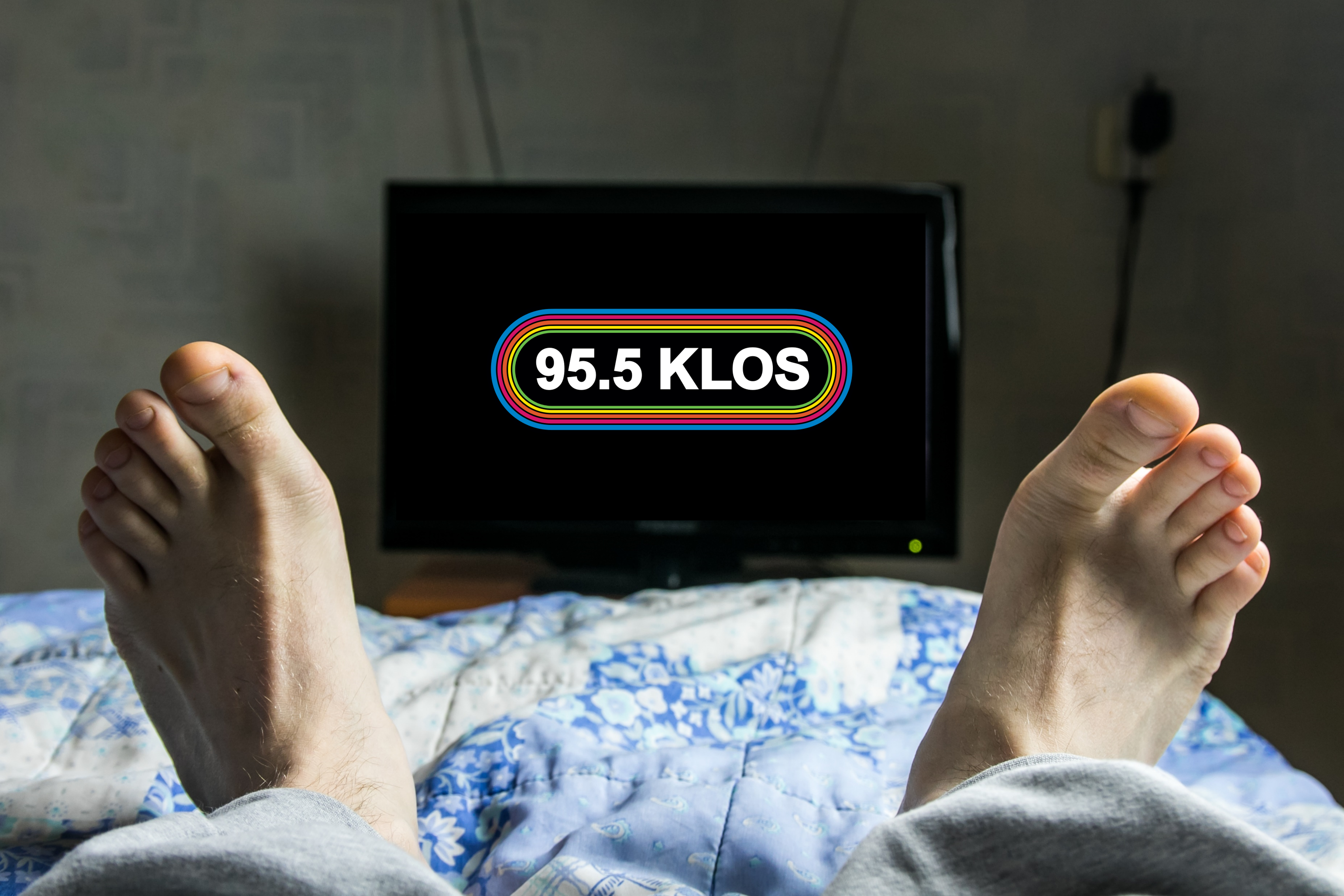
As James Cridland might warn, “No lazy Buggles headline” on this blog. But it’s becoming clearer that as radio broadcasters look for additional digital distribution outlets, TV may represent the next great frontier – for radio.
Radio has benefitted from its streams being available on websites, mobile devices, and of course, smart speakers. As we continue to see each year in our Techsurveys, as “regular radios” continue to disappear on the homefront, other devices take their place, making it possible for consumers to listen whenever they like and wherever they are. No more is radio limited to its terrestrial signal configurations – local stations once bound by the limitations of amplitude and frequency modulation can now travel with us on summer vacation, to new out-of-state homes, away to college, and anywhere we go. For consumers who can no longer play a radio at work, streams available on myriad devices fill in the gaps.
But now, new data reveal there may be even more opportunities for listeners to tune in their favorite stations and shows in the most comfortable rooms of their homes, apartments, and condos. Thanks to the proliferation of smart TVs, more and more consumers are accessing preferred audio on big screen televisions.
A story in Media Play News by Erik Gruenwedel reports on a new study from Hub Entertainment. The key takeaway? Fully, three in four smart TV owners use these devices for non-television purposes. As you might expect, nine of ten 16-34s fall into this category, but so do a majority (55%) of those in the “mature” 55 year-old group – the folks most likely to listen to radio. Consuming audio on these Internet connected TV’s has become “a thing.”
And the most popular non-music TV feature? Listening to streaming music or an audio service. Note this is an increase of 48% since 2020 when the COVID pandemic was rocking our world. Clearly, consumers have learned they can do more with those big screen TVs that stream Netflix.
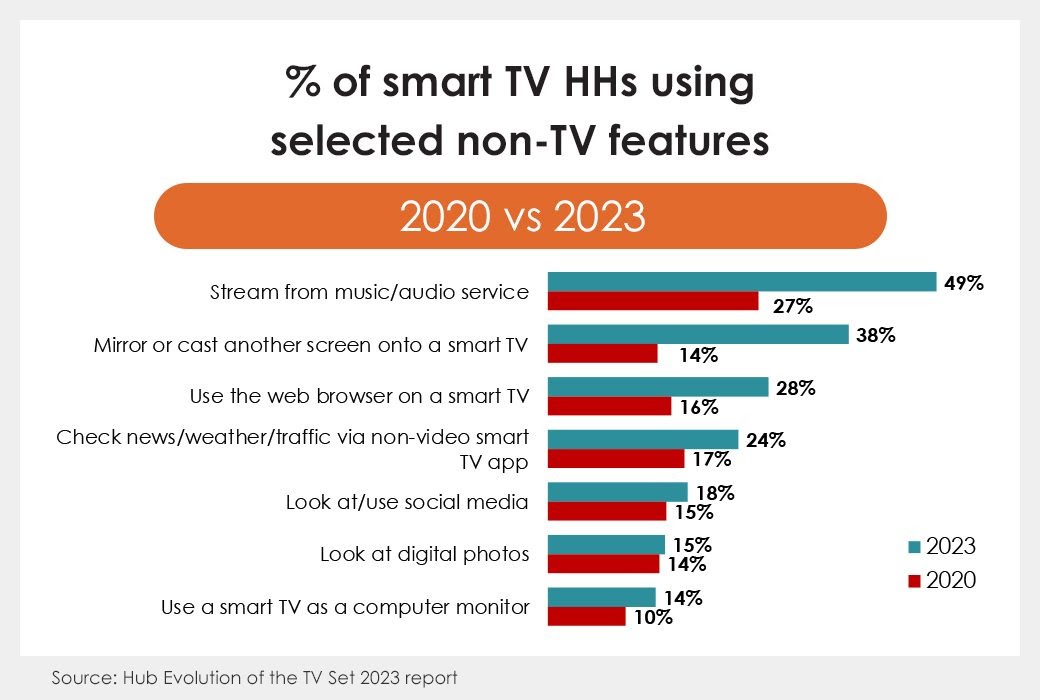
But wait, there’s more. Respondents were asked to express their satisfaction levels with each non-TV feature used. Far and away, six in ten (61%) of those who stream music or listen to an audio service say they’re “very satisfied” with using their TVs this way. No other “use case” for smart TVs comes close in the highest measure of consumer satisfaction.
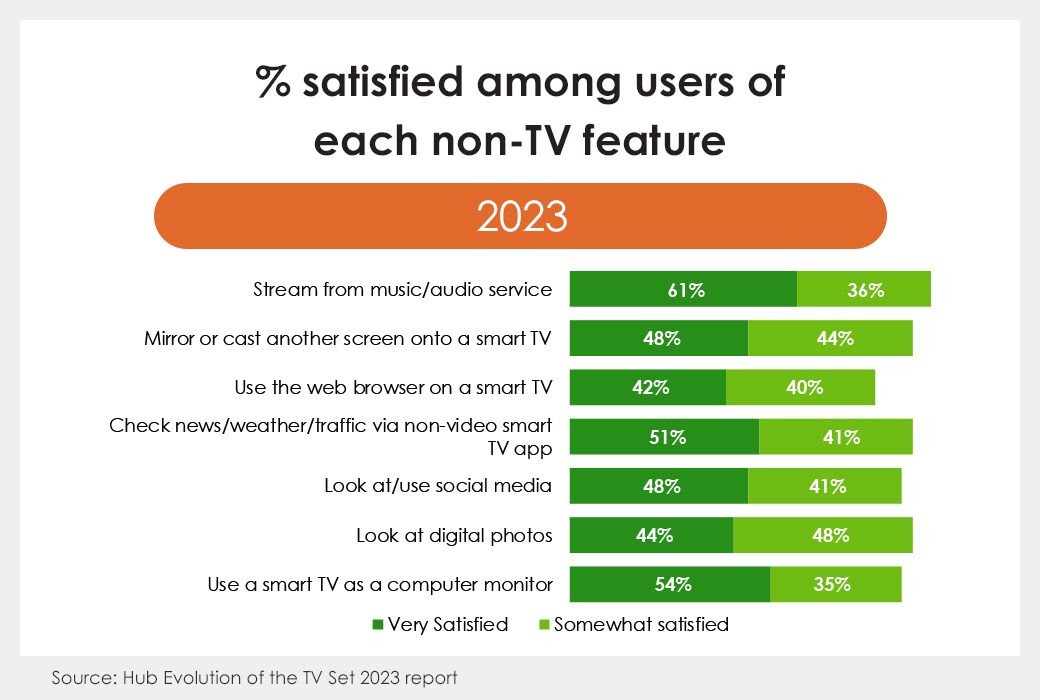
So perhaps now you’re wondering just how many consumers actually own a smart TV, connected to the Internet. Data from the last several Techsurveys tell a critically important story. Keep in mind, our survey is focused on core radio listeners, the ones who do the lion’s share of listening.
COVID was clearly the event that spurred acquisitions of these video gadgets. As pretty much everyone found themselves cooped up at home, many households leveled up their domestic video experiences.
You can see the huge uptrend for smart TV since those tough days in 2020:
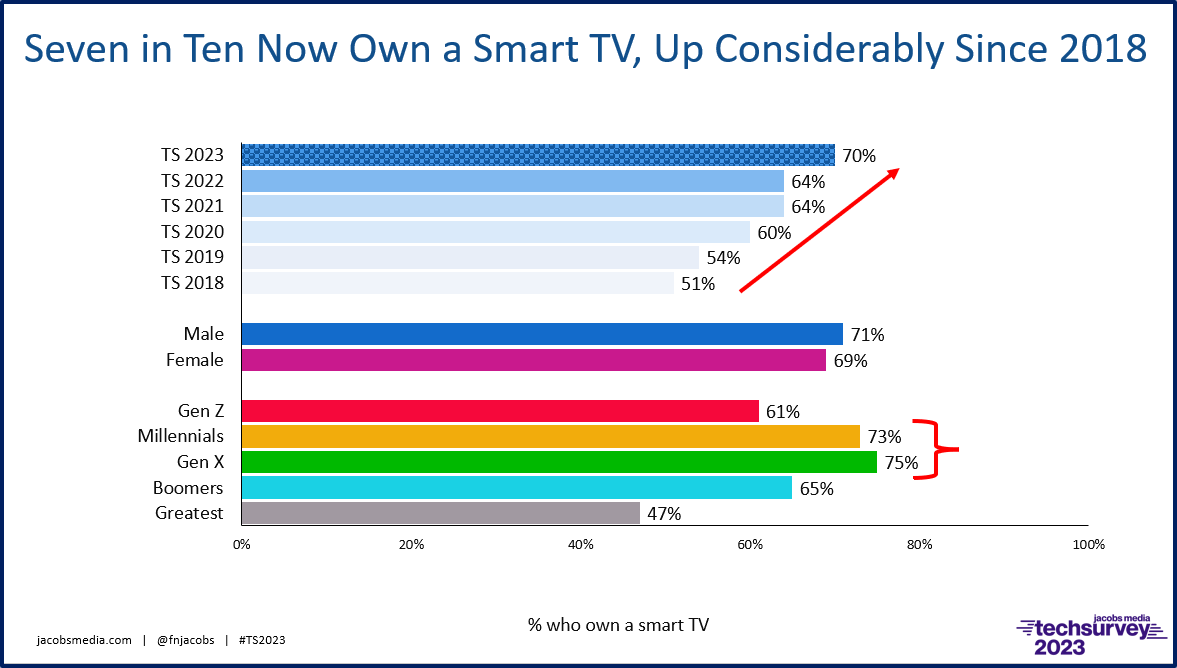
Note how Gen Xers and Millennials are especially likely to fall into the smart TV column.
Like most consumer electronics, the costs of these often mammoth sized televisions have come down considerably over the years. At the entrance of every Costco and Sam’s Club, these video sets are lined up, colorfully displaying video content. You can throw one in your cart, along with a case of ketchup and aspirin.
This spells opportunity for radio, IF broadcasters rise to the occasion and make an effort to utilize smart TVs as an at-home outlet. Similar to the smart phone revolution that took flight 15 or so years ago, radio operators will have to commit to developing apps for these Internet-connected TVs. There’s just a handful of TV brands and most use variations of the Android platform. And of course, millions have Apple TV. Here’s a recent trend report for smart TV brands:
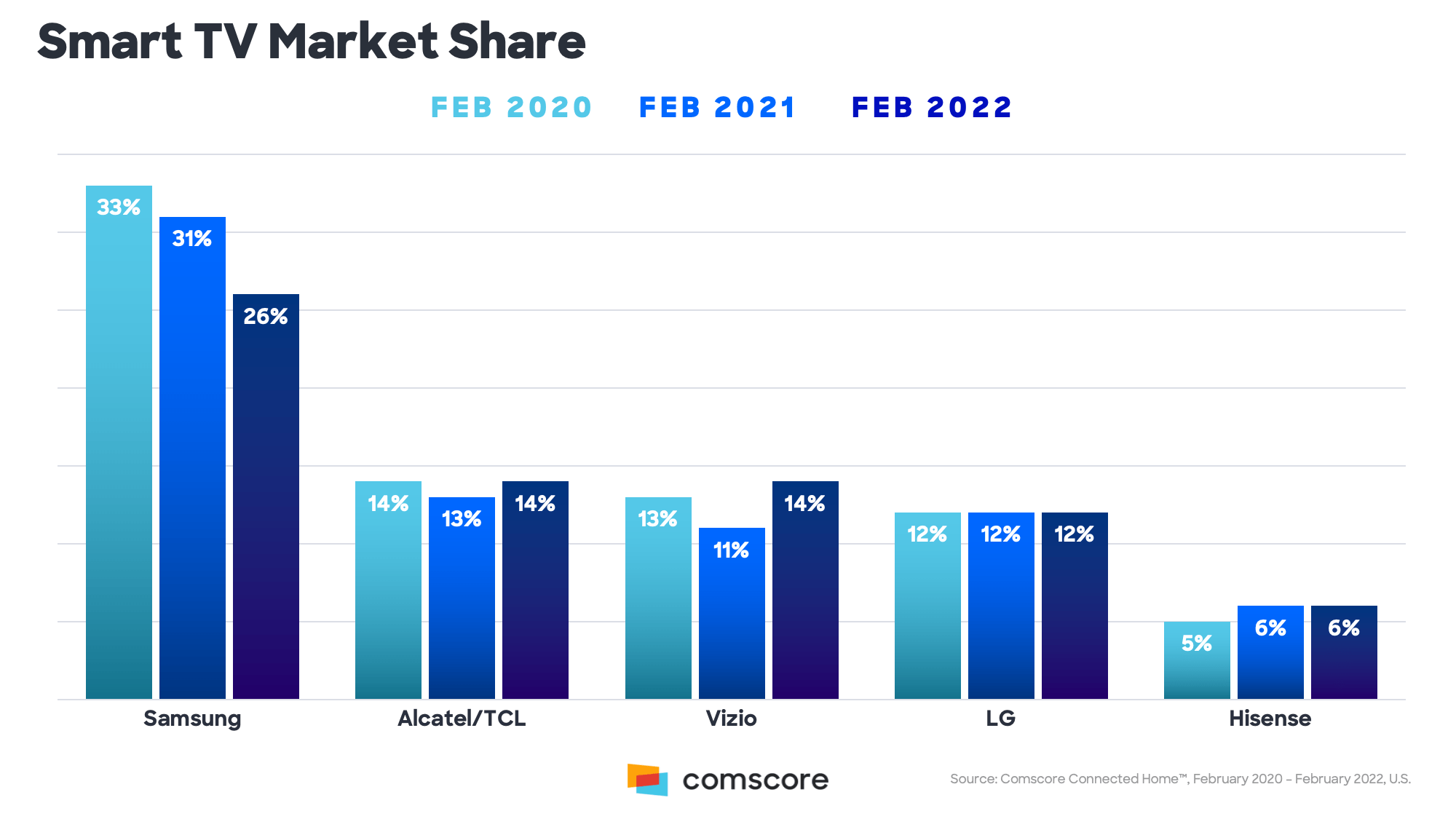
Once your app shows up on TV in your area, you’re good to go. Like other platforms, it’s just a matter of promoting another distribution outlet for your streaming app. With ownership numbers robust among core radio listeners, and with audio streaming being a top use case, it’s hard not to like this smart TV opportunity.
From its very beginning in the 1940s, many predicted television would signal the end of radio’s ubiquity. In the 80s, it was MTV viewed as radio’s potential downfall, showing off the video versions of songs we’d only been able to listen to. And yet, radio survived the “Television Age.” Today, TVs connected to the Internet could help save radio’s growing in-home and at-work problem – if consumers are taught to listen to radio on these devices and its made easy for them.
Each year at CES, we continue to make time to see the latest and greatest in smart TV’s, courtesy of LG, Samsung, Sony, and other manufacturers showing off their latest and greatest video technology. Over the decades, television has been a radio nemesis. Today, it’s a helpful booster and one that could help radio maintain its presence in a key listening location.
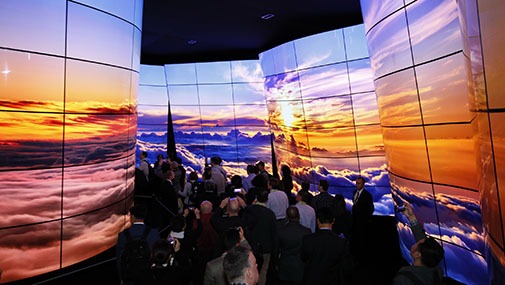
The next time someone asks what’s new on TV, the correct answer is “radio.”
- What To Do If Your Radio Station Goes Through A Midlife Crisis - April 25, 2025
- A 2020 Lesson?It Could All Be Gone In A Flash - April 24, 2025
- How AI Can Give Radio Personalities More…PERSONALITY - April 23, 2025




Apps for smart TVs are a good beginning, Fred, but don’t forget those dongles. I travel with an Amazon fireTVstick, maybe you do too (or perhaps a Roku device), and it lets me access both video and audio streams through hotel TVs so long as they have a working HDML port, free from the constriction of the hotel’s cable contract. Innovative audio streamers (eg, Radio Paradise) complement the audio with contextual still photos so that the screen remains attractive. And TV speakers are approaching “good enough” for a traveler’s purposes.
Plenty of room for broadcast radio to join the party.
Good point, John. Thanks for the reminder.
Great content on the radio is always going to be essential. Fred, you said it. thank you. More receivers, more local content, more success. Here’s to a great new season!
Easy peasy, Clark.
The basic truth is it’s not the delivery system that counts, it’s the content. If radio offers content that listeners want to hear they’ll find a way to listen to it. If it’s just canned content available from a dozen different sources, it’s likely that one of those sources will be more convenient than a radio app. BTW, advertising needs to be counted as content. It needs to entertain and inform like any other content, and be programmed so it’s effective. That means not hearing the same commercial twice in the same stopset, or car dealers back to back. Yes, that means human intervention instead of just dumping numbers into the computer.
Brian, it’s hard to argue. I knew when I wrote this post that people wouldn’t let me get away with just pitching another distribution element without reminding me the content must be competitive. Noted.
Wow, what a great comment. If radio “got” this, radio would be on the offensive, not the defensive, in the “battle for ears.”
Fred that we be great if consumers & homeowners did listen to live local radio thru their smart tvs, Im assuming its th streaming radio commercials that would be heard? not the terestrial spots correct? Being that majority of radio usage is still in the car I assume? than we are still in a challenging space, personally I don’t think radio usage is going up in home or car, especially for the younger generations, I have 3 sons 17, 19 & 21, so they arent tuning in to radio they are using Spotify & Apple, I guess the best we can do is encourage people to stay tuned in and try to keep the listeners we have..Im a big fan of live local radio but the reality is we are losing listeners, I dont think a few smart tvs tuned in are going to make a huge difference..I asked this question many years ago, is it more important to “show” lots of listener engagement or make it seem lots of people are tuning in, or is it more important to have actual real engagement even thought the conservative # of listeners is less, Id rather have real people tuning in loyal engaged any day over saying or showing that radio is alive & well..lol If people don’t hear the commercials whats the point? and streaming audio on local radio is a fraction of the cost of adv compared to the terrestrial signal, so we really need to think abt where radio is going & how we can hold onto our listeners..I dont see my sons deciding to save $11 a month & start listening to Classic rock the same old tired rock songs over & over when they are listening to new incredible hip young rock country R&B artists on spotify & Apple Music, times have changed however my concern is “All” abt our advertisers..thanks,Matt
To your point about your sons, this isn’t about generating new cume (although it’s possible) or attracting youth (probably less possible). But if we can keep existing listeners engaged and tuned in at homme where radios are scarcer, it’s a win.
One good thing about aggregators like TuneIn, iHeartRadio, and Radioplayer is that they do try to cover all sorts of devices. And, when it comes to their TV-related capabilities, they can also include gaming systems (e.g., PlayStation and Xbox).
Thanks, as always, Eric.
You’ve got the right idea here, Fred. In the 80s (before stereo TVs) our local cable company added FM channels so we could hear MTV in stereo. We talked them into putting our (AM) station on another “Cable” FM channel in stereo. You could hear Paul Harvey in stereo. In a more recent time many of our local stations were on the cable lineup in the higher channels. I could hear my station through the TV on channel 941. That’s since been replaced by “Music Choice” – and no one’s made a peep about it. The drawback to Fire Stick, Roku, Android -is the setup. Radio is STILL the one where you flip it on, there it is. If broadcasters could understand the simplicity of it all and use that to their advantage we would be in somewhat better shape than we are today. Like the rest of the services, radio SHOULD be everywhere. Even on my TV.
Exactly, Dave. To not take advantage of all those Smart TVs is a missed opportunity. Appreciate you chiming in.
Hey Dave! I can listen to all I Heart Stations on Cox Cable/San Diego thru the I Heart app, which is offered on my state-of-the art cable “box.” It’s all in the cloud, the “box” the size of a pack of cigarettes. I have yet to purchase a smart TV.
Good one, Mark. Can you call Spectrum and tell them? I have their app-which gets me all the channels in my “bundle” -but nothing more (that I know of). The Spectrum app (on Roku, but not Firestick) is okay. I get it also on the IOS app–but nothing for radio. For those of us in radio, downloading an app for the cable company, and then using another app (iHeart) does seem like a couple of hoops to jump through – my original point. Turn on the radio-and there it is. Then there’s the issue of one cable company on one side of the street and another on the other side- – Cox isn’t available in my neighborhood but Spectrum is. I’m sure it’s the opposite case in many neighborhoods. Radio doesn’t care where you live. It’s just there.
And, don’t forget that the new TV standard, ATSC3.0 (or better known as Next Gen TV) has plenty of bandwidth for all kinds of audio. Of course the lack of receiver penetration and the general confusion in the video business are obsticles. Still..Fred is correct. Getting radio on as many platforms as possible gives us the most flexibiltiy. Another plus for lower powered radio stations would be the added coverage provided by Next Gen TV.
Appreciate it, Jackson.
To the point about advertising being counted as content.
I listened to a lot of Rewound Radio over the weekend as they were streaming WLS and WCFL.
I was struck by how much more entertaining commercials were. The old Pepsi Generation jingles were really catchy (to name one that jumped out at me).
But was it also because the breaks were 2 maybe 3 minutes, too.
Food for thought.
Yes, the commercials WERE better and more memorable and the breaks, if more often, were MUCH shorter. Never even thought about changing the station or tuning elsewhere. I know we can’t live in a “that’s how we used to do it and it worked” past–but does that mean we can’t learn ANYTHING from the past??